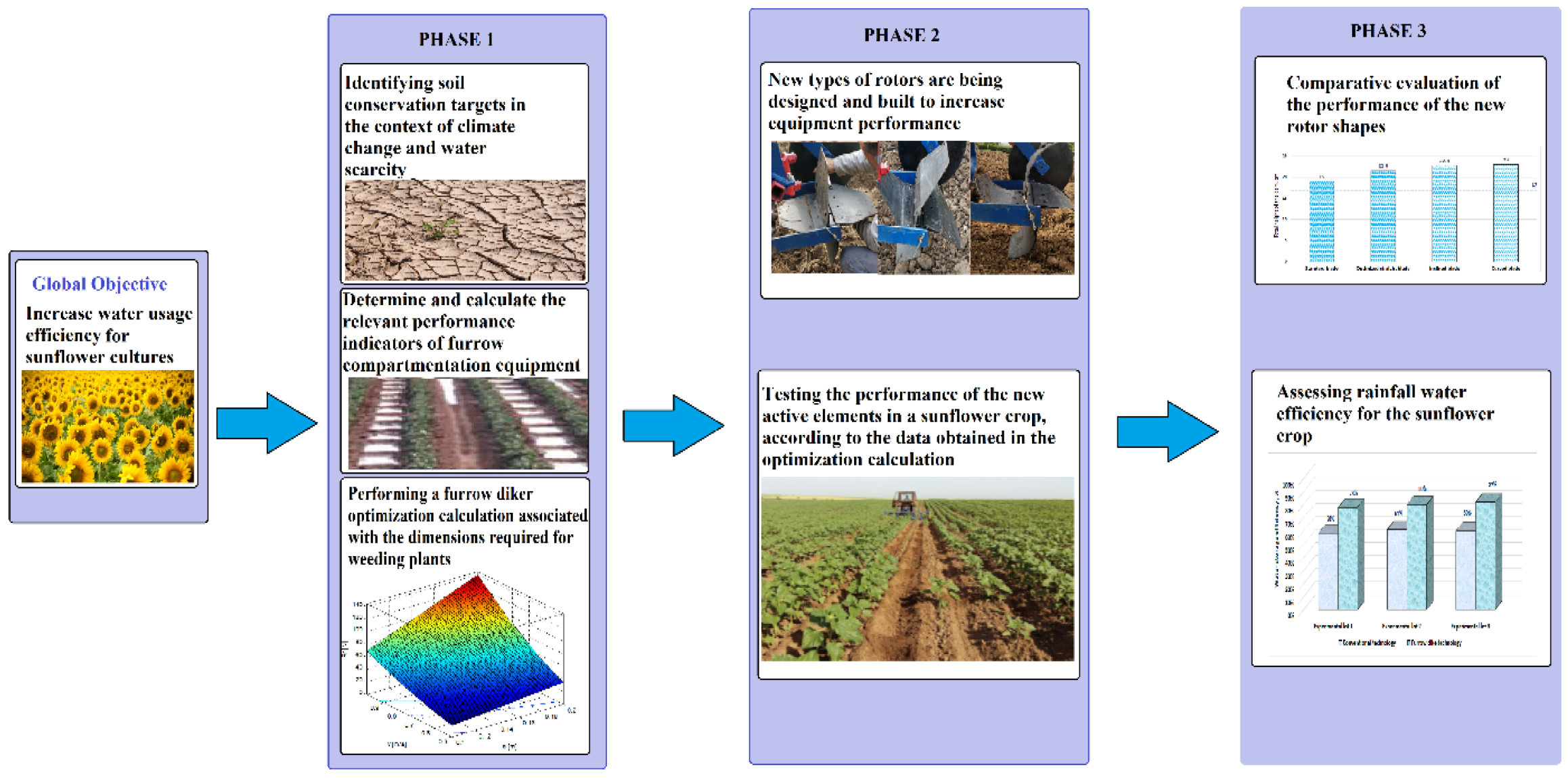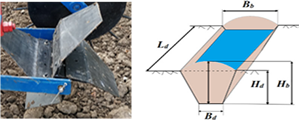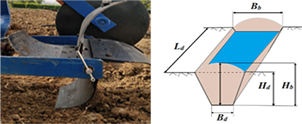Improve the Constructive Design of a Furrow Diking Rotor Aimed at Increasing Water Consumption Efficiency in Sunflower Farming Systems
Abstract
:1. Introduction
2. Materials and Methods
2.1. Research Approach and Expected Output
- Improved water conservation in the soil, as well as reduced evaporation in the root zone;
- Prevention of the performance of a second mechanical plow, which is required in classical technologies;
- Highly effective control measure for weeds in the area between the plants;
- Increased agricultural production by more than 10%, as well as increased efficiency of precipitation capitalization by more than 1.4 kg/ha, per mm of precipitation;
- Improved soil quality through the reduction of topsoil migration due to strong winds;
- Reduced soil loss on sloping terrain caused by rainfall.
2.2. Working Conditions and Environmental Characteristics
2.3. Determination of Agricultural Soil Characteristics
2.4. Description of the Equipment Used for Modeling Soil Compartmentalized Furrows
2.5. Modeling of the Working Process for the Working Surface with the Blade-Type Active Surface–Blade
- -
- The absolute mean, Vma, is calculated with the relation:where vi is the measured value and n is the number of measurements performed.
- -
- The mean square deviation, σa, is calculated with the relation:
- -
- Variation index, Va, is calculated with the relation:
2.6. Optimization of the Equipment for Opening and Compartmenting Furrows for Sunflower Crop
2.7. Design and Testing of Rotor Blades in Accordance with Optimization Calculations
2.8. Evaluation Method of Rainfall Water Efficiency for the Sunflower Crop
3. Results
3.1. Determination of Soil Characteristics
Determination of Penetration Resistance
3.2. Determination of Qualitative Indices for the Equipment for Creating Compartmentalized Furrows
3.2.1. Determination of Quality Indices for Equipment Equipped with Standard Rotor with Straight Blades
3.2.2. Determining Fuel Consumption and Energy Indicators
4. Discussion
4.1. Efficiency in the Usage of the Furrow Compartmenting Equipment (Furrow Diking System)
4.2. Evaluation of the Water Usage and Storage Efficiency from Rainfall
5. Conclusions
Author Contributions
Funding
Institutional Review Board Statement
Informed Consent Statement
Data Availability Statement
Conflicts of Interest
References
- Nenciu, F.; Stanciulescu, I.; Vlad, H.; Gabur, A.; Turcu, O.L.; Apostol, T.; Vladut, V.N.; Cocarta, D.M.; Stan, C. Decentralized Processing Performance of Fruit and Vegetable Waste Discarded from Retail, Using an Automated Thermophilic Composting Technology. Sustainability 2022, 14, 2835. [Google Scholar] [CrossRef]
- Nielsen, D.C.; Vigil, M.F. Legume green fallow effect on soil water content at wheat planting and heat yield. Agron. J. 2005, 97, 684–689. [Google Scholar] [CrossRef]
- Nuti, R.C.; Lamb, M.C.; Sorensen, R.B.; Truman, C.C. Agronomic and economic response to furrow diking tillage in irrigated and non-irrigated cotton. Agric. Water Manag. 2009, 96, 1077–1083. [Google Scholar] [CrossRef]
- Harris, B.L.; Krishna, J.H. Furrow diking to conserve moisture. J. Soil Water Conserv. 1989, 44, 271–273. [Google Scholar]
- Liu, Y.; Xin, Y.; Xie, Y.; Wang, W. Effects of slope and rainfall intensity on runoff and soil erosion from furrow diking under simulated rainfall. Catena 2019, 177, 92–100. [Google Scholar] [CrossRef]
- Cardei, P.; Nenciu, F.; Ungureanu, N.; Pruteanu, M.A.; Vlăduț, V.; Cujbescu, D.; Găgeanu, I.; Cristea, O.D. Using Statistical Modeling for Assessing Lettuce Crops Contaminated with Zn, Correlating Plants Growth Characteristics with the Soil Contamination Levels. Appl. Sci. 2021, 11, 8261. [Google Scholar] [CrossRef]
- Baumhardt, R.L.; Blanco-Canqui, H. Soil Conservation practices. In Encyclopedia of Agriculture and Food Systems; Van Alfen, N., Ed.; Elsevier: San Diego, CA, USA, 2014; Volume 5, pp. 153–165. [Google Scholar]
- Bryant, C.J.; Krutz, L.J.; Nuti, R.C.; Truman, C.C.; Locke, M.A.; Falconer, L.; Atwill, R.L.; Wood, C.W.; Spencer, G.D. Furrow Diking as a Mid-Southern USA Irrigation Strategy: Soybean Grain Yield, Irrigation Water Use Efficiency, and Net Returns above Furrow Diking Costs. Crop Manag. 2019, 5, 1–5. [Google Scholar] [CrossRef]
- Twomlow, S.J.; Bruneau, P.M.C. The influence of tillage on semi-arid soilwater regimes in Zimbabwe. Geoderma 2000, 95, 33–51. [Google Scholar] [CrossRef]
- Ciobotaru, I.E.; Nenciu, F.; Vaireanu, D.I. The Electrochemical Generation of Ozone using an Autonomous Photovoltaic System. Rev. Chim. 2013, 64, 1339–1342. [Google Scholar]
- Truman, C.C.; Nuti, R.C. Improved water capture and erosion reduction through furrow diking. Agric. Water Manag. 2009, 96, 1071–1077. [Google Scholar] [CrossRef]
- Asrstad, J.S.; Miller, D.E. Soil management to reduce runoff under center-pivot sprinkler systems. J. Soil Water Conserv. 1973, 1973. 28, 171–173. [Google Scholar]
- Gerard, C.J.; Sexton, P.D.; Conover, D.M. Effect of furrow diking, subsoiling and slope position on crop yields. Agron. J. 1984, 76, 945–950. [Google Scholar] [CrossRef]
- Nenciu, F.; Vladut, V. Studies on the perspectives of replacing the classic energy plants with Jerusalem artichoke and Sweet Sorghum, analyzing the impact on the conservation of ecosystems. IOP Conf. Ser. Earth Environ. Sci. 2020, 635, 012002. [Google Scholar] [CrossRef]
- Wallace, J.S. Increasing agricultural water use efficiency to meet future food production. Agric. Ecosyst. Environ. 2000, 82, 105–119. [Google Scholar] [CrossRef]
- Hatfield, J.L.; Dold, C. Water-Use Efficiency: Advances and Challenges in a Changing Climate. Front. Plant Sci. 2019, 10, 103. [Google Scholar] [CrossRef]
- Sharma, B.; Molden, D.; Cook, S. Water Use Efficiency in Agriculture: Measurement, Current Situation and Trends, Managing Water and Fertilizer for Sustainable Agricultural Intensification, 39–64. Available online: https://publications.iwmi.org/pdf/H046807.pdf (accessed on 20 March 2022).
- Jones, O.R.; Stewart, B.A. Research study. Basin tillage. Soil Till. Res. 1990, 18, 249–265. [Google Scholar] [CrossRef]
- Jones, O.R.; Clark, R.N. Effects of Furrow Dikes on Water Conservation and Dryland Crop Yields. Soil Water Manag. Conserv. 1987, 51, 1307–1314. [Google Scholar] [CrossRef]
- Baumhardt, R.L. The Dust Bowl Era. In Encyclopedia of Water Science; Stewart, B.A., Howell, T.A., Eds.; Marcel-Dekker: New York, NY, USA, 2003; pp. 187–191. [Google Scholar]
- Balkcom, K.S.; Schomberg, H.H.; Reeves, D.W.; Clark, A.; Baumhardt, R.L.; Collins, H.P.; Delgado, J.A.; Kaspar, T.C.; Mitchell, J.; Duiker, S. Managing cover crops in conservation tillage systems. In Managing Cover Crops Profitably, 3rd ed.; Clark, A., Ed.; Handbook Series Book 9; Sustainable Agriculture Network: Beltsville, MD, USA, 2007; pp. 44–61. [Google Scholar]
- Mircea, C.; Nenciu, F.; Vlǎduț, V.; Voicu, G.; Cujbescu, D.; Gageanu, I.; Voicea, I. Increasing the performance of cylindrical separators for cereal cleaning, by using an inner helical coil. INMATEH Agric. Eng. 2020, 62, 249–258. [Google Scholar] [CrossRef]
- Foote, W.; Nuti, R.; Edmisten, K.; Jordan, D.; Wells, R.; Fisher, L. Crop Responses to Furrow Diking in North Carolina. Crop Manag. 2014, 47, 36–40. [Google Scholar] [CrossRef]
- Irmak, S.; Odhiambo, L.O.; Kranz, W.L.; Eisenhauer, D.E. Irrigation Efficiency and Uniformity, and Crop Water Use Efficiency. Biol. Syst. Eng. Pap. Publ. 2011, 451, 1–8. [Google Scholar]
- Howell, T.A.; Schneider, A.D.; Dusek, D.A. Effects of Furrow Diking on Corn Response to Limited and Full Sprinkler Irrigation. Soil Sci. Soc. Am. J. 2002, 66, 222–227. [Google Scholar] [CrossRef]
- Nenciu, F.; Paraschiv, M.; Kuncser, R.; Stan, C.; Cocarta, D.; Vladut, V.N. High-Grade Chemicals and Biofuels Produced from Marginal Lands Using an Integrated Approach of Alcoholic Fermentation and Pyrolysis of Sweet Sorghum Biomass Residues. Sustainability 2022, 14, 402. [Google Scholar] [CrossRef]
- Bana, R.S.; Bamboriya, S.D.; Padaria, R.N.; Dhakar, R.K.; Khaswan, S.L.; Choudhary, R.L.; Bamboriya, J.S. Planting Period Effects on Wheat Productivity and Water Footprints: Insights through Adaptive Trials and APSIM Simulations. Agronomy 2022, 12, 226. [Google Scholar] [CrossRef]
- Cojocaru, C.; Cocârţă, D.M.; Istrate, I.A.; Creţescu, I. Graphical Methodology of Global Pollution Index for the Environmental Impact Assessment Using Two Environmental Components. Sustainability 2017, 9, 593. [Google Scholar] [CrossRef]



























| The Main Quality Indices (Standard Blade) | Hb [cm] | Hd [cm] | Bb [cm] | Bd [cm] | Ld [cm] |
|---|---|---|---|---|---|
 | 20 | 16 | 40.5 | 9.7 | 300 |
| 18 | 13 | 40 | 9.2 | 275 | |
| 19 | 15 | 41 | 8.9 | 270 | |
| 18 | 14 | 42 | 11.0 | 250 | |
| 20 | 15 | 39.5 | 10.7 | 260 | |
| Absolute average, Vma, [cm] | 19 | 14.6 | 40.6 | 9.9 | 271 |
| The mean square deviation, σa, [cm] | 1.0 | 1.14 | 0.96 | 0.92 | 18.84 |
| Variation index, Va [%] | 5.26 | 7.81 | 2.37 | 9.28 | 6.95 |
| The Main Quality Indices (Optimized Right Blade) | Hb [cm] | Hd [cm] | Bb [cm] | Bd [cm] | Ld [cm] |
|---|---|---|---|---|---|
 | 20 | 18 | 48 | 17 | 280 |
| 22 | 17.5 | 49 | 16 | 290 | |
| 21 | 17 | 46 | 15 | 270 | |
| 23 | 17 | 48.5 | 16 | 260 | |
| 22 | 18 | 46.5 | 18 | 265 | |
| Absolute average, Vma, [cm] | 21.6 | 17.5 | 47.6 | 16.4 | 273 |
| The mean square deviation, σa, [cm] | 1.14 | 0.5 | 1.25 | 1.14 | 12.04 |
| Variation index, Va [%] | 5.28 | 2.86 | 2.64 | 6.95 | 4.41 |
| The Main Quality Indices (Optimized Inclined Blade) | Hb [cm] | Hd [cm] | Bb [cm] | Bd [cm] | Ld [cm] |
|---|---|---|---|---|---|
 | 23.5 | 17.5 | 49 | 18 | 285 |
| 23 | 19 | 46 | 16.5 | 290 | |
| 24 | 17 | 47 | 17 | 270 | |
| 22.5 | 19 | 50 | 15.5 | 265 | |
| 21 | 18.5 | 48 | 16 | 260 | |
| Absolute average, Vma, [cm] | 22.8 | 18.2 | 48 | 16.6 | 274 |
| The mean square deviation, σa, [cm] | 1.21 | 0.91 | 1.0 | 0.96 | 13.51 |
| Variation index, Va [%] | 5.33 | 5.0 | 2.1 | 5.8 | 4.93 |
| The Main Quality Indices for the Curved Blade | Hb [cm] | Hd [cm] | Bb [cm] | Bd [cm] | Ld [cm] |
|---|---|---|---|---|---|
 | 24 | 19.5 | 50 | 16 | 290 |
| 22 | 19 | 48 | 17 | 260 | |
| 21.5 | 20 | 47 | 18.5 | 270 | |
| 23 | 20 | 49 | 17.5 | 280 | |
| 24.5 | 21 | 51 | 16.5 | 270 | |
| Absolute average, Vma, [cm] | 23 | 19.9 | 49 | 17.1 | 274 |
| The mean square deviation, σa, [cm] | 1.27 | 0.,59 | 1.58 | 0.96 | 11.4 |
| Variation index, Va [%] | 5.54 | 2.96 | 3.1 | 5.62 | 4.16 |
Publisher’s Note: MDPI stays neutral with regard to jurisdictional claims in published maps and institutional affiliations. |
© 2022 by the authors. Licensee MDPI, Basel, Switzerland. This article is an open access article distributed under the terms and conditions of the Creative Commons Attribution (CC BY) license (https://creativecommons.org/licenses/by/4.0/).
Share and Cite
Nenciu, F.; Oprescu, M.R.; Biris, S.-S. Improve the Constructive Design of a Furrow Diking Rotor Aimed at Increasing Water Consumption Efficiency in Sunflower Farming Systems. Agriculture 2022, 12, 846. https://doi.org/10.3390/agriculture12060846
Nenciu F, Oprescu MR, Biris S-S. Improve the Constructive Design of a Furrow Diking Rotor Aimed at Increasing Water Consumption Efficiency in Sunflower Farming Systems. Agriculture. 2022; 12(6):846. https://doi.org/10.3390/agriculture12060846
Chicago/Turabian StyleNenciu, Florin, Marius Remus Oprescu, and Sorin-Stefan Biris. 2022. "Improve the Constructive Design of a Furrow Diking Rotor Aimed at Increasing Water Consumption Efficiency in Sunflower Farming Systems" Agriculture 12, no. 6: 846. https://doi.org/10.3390/agriculture12060846
APA StyleNenciu, F., Oprescu, M. R., & Biris, S.-S. (2022). Improve the Constructive Design of a Furrow Diking Rotor Aimed at Increasing Water Consumption Efficiency in Sunflower Farming Systems. Agriculture, 12(6), 846. https://doi.org/10.3390/agriculture12060846







